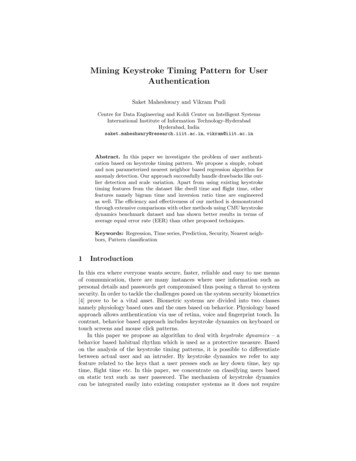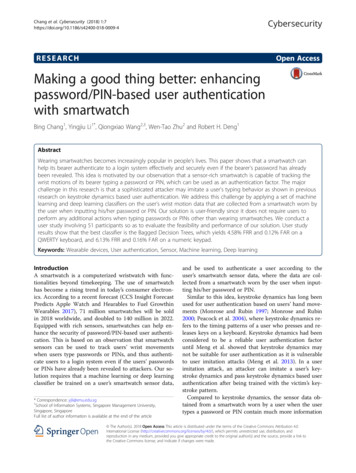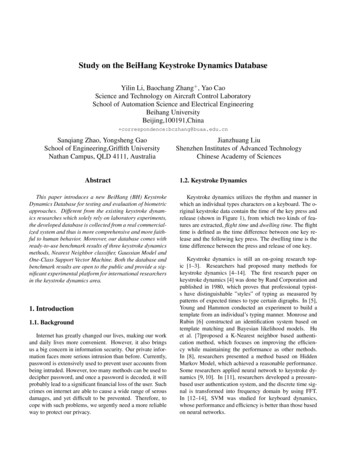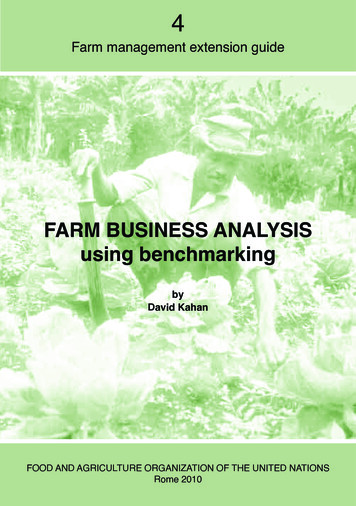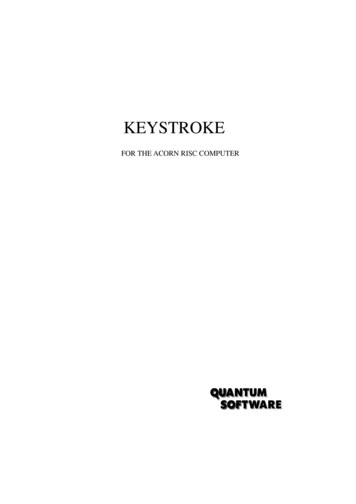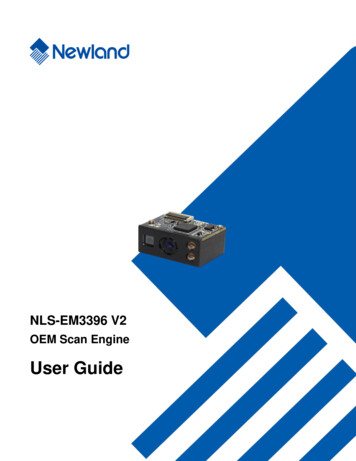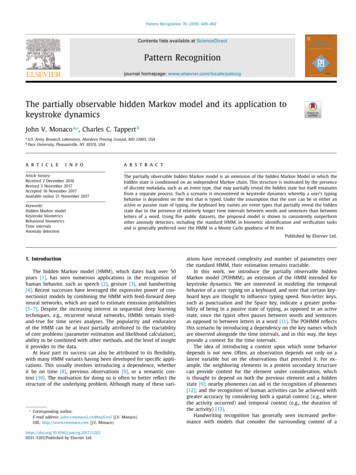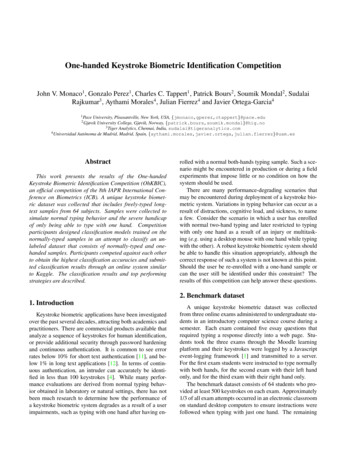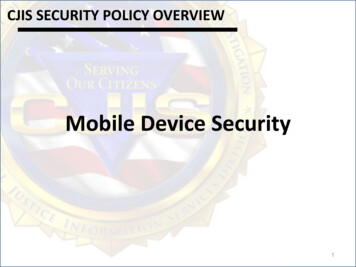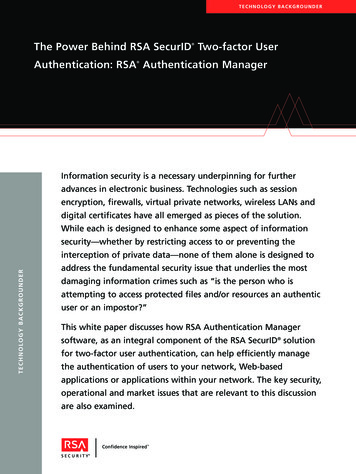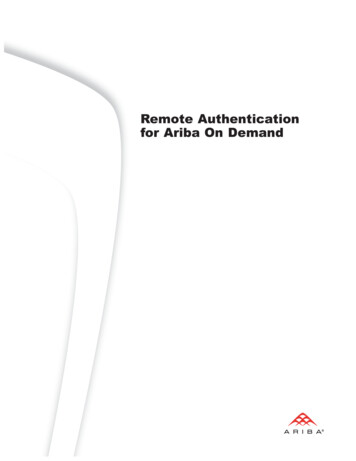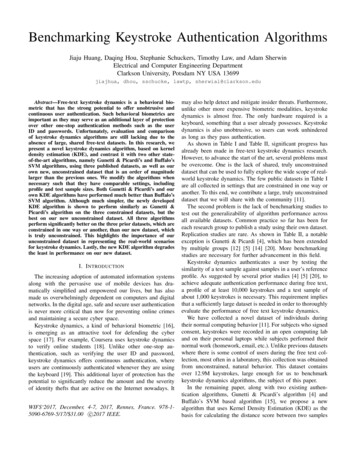
Transcription
Benchmarking Keystroke Authentication AlgorithmsJiaju Huang, Daqing Hou, Stephanie Schuckers, Timothy Law, and Adam SherwinElectrical and Computer Engineering DepartmentClarkson University, Potsdam NY USA 13699jiajhua, dhou, sschucke, lawtp, sherwial@clarkson.eduAbstract—Free-text keystroke dynamics is a behavioral biometric that has the strong potential to offer unobtrusive andcontinuous user authentication. Such behavioral biometrics areimportant as they may serve as an additional layer of protectionover other one-stop authentication methods such as the userID and passwords. Unfortunately, evaluation and comparisonof keystroke dynamics algorithms are still lacking due to theabsence of large, shared free-text datasets. In this research, wepresent a novel keystroke dynamics algorithm, based on kerneldensity estimation (KDE), and contrast it with two other stateof-the-art algorithms, namely Gunetti & Picardi’s and Buffalo’sSVM algorithms, using three published datasets, as well as ourown new, unconstrained dataset that is an order of magnitudelarger than the previous ones. We modify the algorithms whennecessary such that they have comparable settings, includingprofile and test sample sizes. Both Gunetti & Picardi’s and ourown KDE algorithms have performed much better than Buffalo’sSVM algorithm. Although much simpler, the newly developedKDE algorithm is shown to perform similarly as Gunetti &Picardi’s algorithm on the three constrained datasets, but thebest on our new unconstrained dataset. All three algorithmsperform significantly better on the three prior datasets, which areconstrained in one way or another, than our new dataset, whichis truly unconstrained. This highlights the importance of ourunconstrained dataset in representing the real-world scenariosfor keystroke dynamics. Lastly, the new KDE algorithm degradesthe least in performance on our new dataset.I. I NTRODUCTIONThe increasing adoption of automated information systemsalong with the pervasive use of mobile devices has dramatically simplified and empowered our lives, but has alsomade us overwhelmingly dependent on computers and digitalnetworks. In the digital age, safe and secure user authenticationis never more critical than now for preventing online crimesand maintaining a secure cyber space.Keystroke dynamics, a kind of behavioral biometric [16],is emerging as an attractive tool for defending the cyberspace [17]. For example, Coursera uses keystroke dynamicsto verify online students [18]. Unlike other one-stop authentication, such as verifying the user ID and password,keystroke dynamics offers continuous authentication, whereusers are continuously authenticated whenever they are usingthe keyboard [19]. This additional layer of protection has thepotential to significantly reduce the amount and the severityof identity thefts that are active on the Internet nowadays. ItWIFS‘2017, December, 4-7, 2017, Rennes, France. 978-15090-6769-5/17/ 31.00 c 2017 IEEE.may also help detect and mitigate insider threats. Furthermore,unlike other more expensive biometric modalities, keystrokedynamics is almost free. The only hardware required is akeyboard, something that a user already possesses. Keystrokedynamics is also unobtrusive, so users can work unhinderedas long as they pass authentication.As shown in Table I and Table II, significant progress hasalready been made in free-text keystroke dynamics research.However, to advance the start of the art, several problems mustbe overcome. One is the lack of shared, truly unconstraineddataset that can be used to fully explore the wide scope of realworld keystroke dynamics. The few public datasets in Table Iare all collected in settings that are constrained in one way oranother. To this end, we contribute a large, truly unconstraineddataset that we will share with the community [11].The second problem is the lack of benchmarking studies totest out the generalizability of algorithm performance acrossall available datasets. Common practice so far has been foreach research group to publish a study using their own dataset.Replication studies are rare. As shown in Table II, a notableexception is Gunetti & Picardi [4], which has been extendedby multiple groups [12] [5] [14] [20]. More benchmarkingstudies are necessary for further advancement in this field.Keystroke dynamics authenticates a user by testing thesimilarity of a test sample against samples in a user’s referenceprofile. As suggested by several prior studies [4] [5] [20], toachieve adequate authentication performance during free text,a profile of at least 10,000 keystrokes and a test sample ofabout 1,000 keystrokes is necessary. This requirement impliesthat a sufficiently large dataset is needed in order to thoroughlyevaluate the performance of free text keystroke dynamics.We have collected a novel dataset of individuals duringtheir normal computing behavior [11]. For subjects who signedconsent, keystrokes were recorded in an open computing laband on their personal laptops while subjects performed theirnormal work (homework, email, etc.). Unlike previous datasetswhere there is some control of users during the free text collection, most often in a laboratory, this collection was obtainedfrom unconstrained, natural behavior. This dataset containsover 12.9M keystrokes, large enough for us to benchmarkkeystroke dynamics algorithms, the subject of this paper.In the remaining paper, along with two existing authentication algorithms, Gunetti & Picardi’s algorithm [4] andBuffalo’s SVM based algorithm [15], we propose a newalgorithm that uses Kernel Density Estimation (KDE) as thebasis for calculating the distance score between two samples
StudyMonrose and Rubin [1]Monrose and Rubin [2]Dowland and Furnell [3]Gunetti and Picardi [4] (Torino)Messerman et al. [5]Ahmed and Traore [6]Janakiraman and Sim [7]Stewart et al. [8]Vural et al. [9] (Clarkson I)Sun et al. [10] (Buffalo)Ours [11] (Clarkson II)#User31633540/1655553223039148103Time Span7 weeks11 months3 months6 months12 months5 months2 weeks4 tests in 3 weeks2 sessions28 days2.5 yearsLogger SettingUI, set tasksUI, set tasksUncontrolled, loggerWeb UIWeb UI (email)Uncontrolled, loggerUncontrolled, loggerWeb UI, short answersWeb UI, tasksWeb UI, tasksUncontrolled#KeystrokesN/AN/A3.4 M400 K293 K9.5 M9.5 M720 K840 K2.14 M12.9 MAvailabilityNONONOYESNONONONOYESYESYESTab. I: Free-text keystroke datasets from the literature. There are 165 imposters in Gunetti and Picardi’s dataset [4].StudyFeature & Dataset UsedAlgorithmGunetti and Picardi [4]n-graphflighttime(n 2,3,4)digraph, 21 / 165 [4]Sum of degree of disorderand n-graph reject ratioSumofdegreeofdisorder and difference ofhistogram-based densityestimationDegree of disorder, crosscorrelationRandom forestsDegree of disorderEuclideandistance,(weighted) probabilityacceptancewindow,threshold on number ofalertsBhattacharyya distanceDavoudi and Kabir [12]Xi et al. [13]digraph, 21 / 165 [4]Shimshon et al. [14]Messerman et al. [5]Monrose and Rubin [1] [2]digraph, 21 / 165 [4]n-graphdigraphDowland and Furnell [3]digraphJanakiraman and Sim [7]key dwell time and digraph flight timedigraphkey dwell time and digraph flight timeStewart et al. [8]Ahmed and Traore [6]Ceker et al. [15]key dwell time and digraph flight time [9]KNNratio of n-graph acceptance, Neural network forlearning missing featuresOne-class R or accuracy (%)1.7391.1-93.24.9074-1000.0152 4.820.52.5000Tab. II: Authentication algorithms and performance based on free-text keystroke dynamics.(Section III). We benchmark the three algorithms using fourdatasets, the Torino dataset [4], the Clarkson I dataset [9],the Buffalo dataset [10], and our own new, unconstraineddataset (Clarkson II) [11] (Section II). We present the resultsin Section IV, and conclude our paper in Section V.II. DATASETSFour datasets are used to benchmark our KDE based algorithm with the other two. In the following, we introduce thesedatasets in the chronological order by which they are created.B. Clarkson I DatasetThe Clarkson I dataset is collected in a laboratory at Clarkson University [9]. This dataset contains two sessions for eachparticipant that are separated by at least a few days. All thekeystrokes are collected in the lab by using the same computerand keyboard, and running the same web browser. Theyare mostly free text keystrokes where participants transcribegiven passages or answer survey questions that are carefullydesigned around the interests of the subject population toensure fluent response. The dataset contains a total of 840Kkeystrokes, obtained from 39 participants.A. Torino DatasetThe Torino dataset is collected by Gunetti & Picardi [4].This dataset is in Italian. Participants are asked to open a webpage in their browser to fill up HTML forms with whateverthey feel comfortable to type. Each session is about 800keystrokes, and a participant can type at most one sessioneach day. The dataset contains 400K keystrokes in total, from40 participants [4]. It also contains another 165 users whocontribute only one sample, to be used as attack. This datasetcontains only key press time, but without the key release time.C. Buffalo DatasetThe Buffalo dataset is collected by researchers at SUNYBuffalo [10]. This dataset is a mix of (long) fixed text andfree text keystrokes, collected in a laboratory. There are 148participants, with a total of 2.14M keystrokes in this dataset.The average user contributes 1.44K keystrokes, with a maxof 18.3K. Most users have visited the lab in 3 sessions [10].Four different kinds of keyboards are used. Some participantsare deliberately required to use different kinds of keyboards
during different sessions. So this dataset can be used to test outany difference that the keyboards may make on authentication.D. Our Own New, Unconstrained Dataset (Clarkson II)Unlike the other three datasets described above, our newdataset, Clarkson II, is completely unconstrained [11]. AWindows based logger loaded on a user’s own computerpassively records all keystrokes from a user’s natural behavior,without requiring or restricting them to do anything special.This dataset contains a total of 12.9M keystrokes, from 103participants. The average user contributes 125K keystrokes,with a max of 625K. Our dataset is collected over a long spanof 2.5 years, so it can also be used to study the long-termconsistency of a user’s typing behavior.III. A LGORITHMSWe compare our Kernel Density Estimation (KDE) basedalgorithm with two existing algorithms: Gunetti & Picardialgorithm [4] and Buffalo’s SVM based algorithm [15].We re-implement Gunetti & Picardi’s algorithm [4] as theevaluation algorithm because it represents the state-of-theart in free text keystroke dynamics. As shown in Tab. II,this algorithm has been the subject of multiple follow-upstudies [12] [5] [14] [20]. We choose the SVM based algorithmbecause it represents a machine learning based approach [15].Informed by prior studies [4] [5] [20], we use 10,000keystrokes as the profile, and 1,000 keystrokes as a test sample.In all cases, we calculate a distance score, and compare it withan acceptance threshold to make accept/reject decisions. Bysystematically varying the thresholds, we are able to createDET (Detection Error Tradeoff) curves and calculate EER(Equal Error Rate) for each algorithm/dataset pair.A. KDE Based AlgorithmIn statistics, kernel density estimation (KDE) is a nonparametric way to estimate the probability density function(PDF) of a random variable. Kernel density estimation is afundamental data smoothing problem where inferences aboutthe population are made based on a finite data sample [21].We use KDE to estimate the probability density of a digraphin the profile and in a test sample. The estimated PDFsare used to calculate the distance between reference profilesamples and test samples. Specifically, in our implementation, we use a function in Python that is called statsmodels.api.nonparametric.KDEUnivariate to estimate PDFs.Under ideal circumstances (the distribution is known anddensity is well behaved), a sample size of at least 4 data pointsis required in order to run KDE for one dimensional data [21].This is in agreement with our experience. When we estimatethe PDFs using KDE for only digraphs that have 4 or moreinstances in both the profile and test samples, we get the bestperformance results. When we also apply KDE to digraphs thathave fewer than 4 instances, our performance results becomeworse. On the other hand, when we only use those digraphsthat have enough instances, as features, fewer digraphs qualify.As a result, fewer features are used in authentication, resultingin worse performance. By using KDE for those digraphs thathave enough instances, but using average density for those thatdo not, we get the best performance. The details of fusing thesetwo are presented as follows.For each digraph that has four or more instances in boththe profile and the test samples, we estimate two PDFs usingKDE. Note that the PDFs are functions of digraph flight time.For each value between 0 to 500 ms, we calculate the absolutedifference of the two PDFs. We sum up all the differences forthe digraph. Finally, we calculate an average PDF difference,D, for all such digraphs (those with four or more instances).For each digraph that has four or more instances in theprofile sample, but not so in the test sample, we use thePDF estimated for the profile sample to calculate the averageprobability density for all the instances in the test sample.Finally, we calculate an average probability density, d, for allsuch digraphs (those with fewer than four instances).Our final distance score between two samples is a weightedsum of the average PDF difference, D, and the averageprobability density, d, namely, D 20 d, where the weightcoefficient 20 is determined by trial and error.Finally, in the extremely unlikely case where none of thedigraphs shared by the profile sample and the test samplecontains enough instances, the test sample will be rejected.B. Gunetti & Picardi’s AlgorithmGiven a test sample X and a user A, Gunetti & Picardi’salgorithm verifies whether X comes from A [4]. Specifically, itcalculates the distance between samples in the profile of A andtest sample X. If the distance is larger than the set threshold,it rejects the test sample as from an intruder. Otherwise, itaccepts the test sample as from the genuine user A.The distance between two typing samples S1 and S2 is measured in terms of shared n-graphs (n consecutive keystrokes), using ‘A’ measure (for “Absolute”) and ‘R’ measure (for“Relative”). ‘A’ measure uses the difference in average ngraph latencies to determine distance. ‘R’ measure uses thenormalized rank difference between two ordered vectors ofaverage n-graph latencies to determine distance [4].The ‘A’ measure between S1 and S2 is defined in terms ofthe n-graphs they share and a constant value t:At,n (S1, S2) 1 #similar/#sharedwhere #similar represents the number of similar n-graphsshared by S1 and S2, and #shared the total number of ngraphs shared.The constant t is needed for defining n-graph similarity.Specifically, let GS1,d1 and GS2,d2 be the same n-graphoccurring in typing samples S1 and S2, with duration d1 andd2, respectively. We say that GS1,d1 and GS2,d2 are similar if1 max(d1, d2)/min(d1, d2) t, where t is a constantgreater than 1 (we used t 1.25).C. Buffalo’s SVM Based AlgorithmBuffalo’s algorithm uses the most common D digraphsfrom a dataset as features. Three features are created for eachdigraph instance: the two dwell times for the two letters and
Fig. 1: DET curves for Torino dataset (X-axis: False Accept Rate, Yaxis: False Reject Rate). EER for the three algorithms, KDE, Gunetti& Picardi, and SVM, are 0.0348, 0.0311, and 0.1688, respectively.Fig. 2: DET curves for Clarkson Dataset I. EER for KDE, Gunetti& Picardi, and SVM are 0.0336, 0.0217, and 0.0377, respectively.the flight time. A D 3 dimension feature vector is createdfor each digraph instance, where 3 slots represent the featuresfor the instance, and all the other slots are filled with 0s. Theytrain a one-class SVM classifier using 80% of the data for eachof the 34 users. Authentication decisions are made by pickingthe user whose classifier yields the highest total score for allthe instances in the remaining 20% of the data [15]. Insteadof an 80/20% split, in our benchmarking, all three algorithmshave used the same profile size of 10,000 and test sample sizeof 1,000 keystrokes.The more digraphs the SVM algorithm uses, the better itsperformance [15]. For the Clarkson I dataset, we use the same27 most frequent digraphs used in the original paper [15].We scan the other two datasets to identify the most frequentdigraphs. The most frequent digraphs for the Buffalo datasetand our new dataset are almost identical to those found inClarkson I, but a very different set is used for the Torinodataset as it is in a different language (Italian).Fig. 3: DET curves for Buffalo dataset. EER for KDE, Gunetti &Picardi, and SVM are 0.0195, 0.0375, and 0.0493, respectively.Fig. 4: DET curves for our unconstrained dataset (Clarkson II). EERfor KDE, Gunetti & Picardi, and SVM are 0.0759, 0.1036, and0.1567, respectively. FAR (False Accept Rate): The ratio of impostor attacksthat are falsely accepted as genuine users.FRR (False Reject Rate): The ratio of genuine tests thatare falsely rejected as impostors.EER (Equal Error Rate): The point on a DET curve whereFAR and FRR are equal.D. Evaluation MetricsWe measure the authentication performance for keystrokedynamics using three standard metrics:Fig. 5: DET curves for the KDE algorithm.
Fig. 6: DET curves for the Gunetti & Picardi algorithm.Fig. 7: DET curves for the SVM algorithm.IV. R ESULTS OF E VALUATIONThree algorithms, our own KDE-based algorithm, Gunetti& Picardi [4], and the SVM based algorithm [15], are benchmarked using the four datasets described in Section II. Allthree algorithms are tested out using the same profile size of10,000 keystrokes and a test sample size of 1,000 keystrokes.A. DET Curves by DatasetsFigures 1, 2, 3, and 4 depict the Detection Error Tradeoff(DET) curves of running the three algorithms on the fourdatasets, Torino, Clarkson I, Buffalo, and our own new,unconstrained dataset (Clarkson II), respectively.As shown in Figure 1, using the Torino dataset, our KDEalgorithm performs slightly better than Gunetti & Picardi.Both are much better than SVM. The degradation on SVM’sperformance on this dataset is very likely due to the fact thatthe Torino dataset does not contain the key release time thatDatasetTorino [4]Clarkson I [9]Buffalo [10]Clarkson II [11]KDE0.03480.03360.01950.0759Gunetti & Picardi [4]0.03110.02170.03750.1036SVM [15]0.16880.03770.04930.1567Tab. III: EERs for the three algorithms on the four datasets.is needed for calculating key dwell time. As a result, no dwelltime is calculated for each key, and running SVM algorithmwithout the dwell time makes it perform much worse.Figure 2 shows the DET curves of running the three algorithms on the Clarkson I dataset. All three algorithms performbetter on this dataset than Torino. Moreover, Gunetti & Picardidoes better than the other two. Note that the SVM algorithmhas been reported to produce much better performance resultson the same dataset [15] than our experiment. This is verylikely due to the fact that different data sizes are used in thetwo experiments. They have used a much larger profile sizeand test sample size: 80% and 20% of each user’s data [15].In contrast, to enable a fair comparison, we have used a profilesize of 10,000 keystrokes and a test sample size of 1,000.Figure 3 shows the DET curves for the Buffalo dataset. Onthis dataset, out of the three, the KDE algorithm achieves thebest performance (EER of 0.0195), and the SVM algorithmperforms the worst (EER of 0.0493).Figure 4 shows the DET curves for our new, unconstraineddataset (Clarkson II), where KDE performs the best andSVM the worst. Note that all three algorithms perform theworst on our new dataset than on the other three datasetsas shown in Figures 1, 2, and 3. Moreover, the performancedifference between the three algorithms on our new dataset isalso quite large. We believe that this performance degradationand variation are due to the fact that our new dataset isunconstrained and thus contains much more ‘noisy’ keystrokesthan the other three.B. DET Curves by AlgorithmsTo facilitate comparison, Figures 5, 6, and 7 depict the DETcurves of running the three algorithms on the four datasets, andTable III depicts the EERs.Figure 5 shows the DET curves for running the KDEalgorithm on the four datasets. As shown, the KDE algorithmhas similar performance on the first three datasets, whichare much cleaner than Clarkson II due to the ways theyare collected. It is noteworthy that the KDE algorithm stillperforms reasonably well on Clarkson II, despite the fact thatit is unconstrained and contains much more ‘noisy’ data.Figure 6 shows DET curves for the Gunetti & Picardialgorithm [4]. This algorithm achieves similar performance onthe Torino dataset and Clarkson I, but degrades significantlyon the Buffalo dataset, and even worse on our Clarkson II.Figure 7 shows DET curves for the SVM algorithm [15].This algorithm performs similarly on Clarkson I and theBuffalo dataset, but significantly worse on Torino and ClarksonII. As we note earlier, the poor performance on the Torinodataset can be attributed to the fact that it does not have the keyrelease time that SVM requires to calculate the key dwell time.Moreover, the poor performance on our Clarkson II indicatesthat it is sensitive to the ‘noise’ in the data.C. SummaryAs shown in Table III, both the KDE and Gunetti &Picardi’s algorithms perform better than the SVM algorithm
consistently across the four datasets. The main reason for thisdifference is that the former two use many more features, oftenhundreds of n-graphs, than the two dozens or so features usedin the SVM algorithm [15]. As a result, the dwell time isespecially important for the SVM algorithm. When dwell timesare missing in the Torino dataset, its performance degradessignificantly (Figure 7).As shown in Table III, the four datasets disagree on whetherour KDE algorithm is better than Gunetti & Picardi’s algorithm [4]. However, it is clear that all of the algorithmsdo not perform as well on unconstrained datasets as laboratory datasets. Our KDE algorithm responds to unconstrained,‘noisy’ data in the most robust way, and performs the best.V. C ONCLUSIONOur new KDE-based algorithm has the best EER on theBuffalo dataset and our new, unconstrained dataset (ClarksonII), whereas Gunetti & Picardi’s algorithm has better EERon the other two datasets. Buffalo’s SVM has the worstperformance on all four datasets.The KDE algorithm shows similar performance on theBuffalo, Clarkson, and Torino datasets. Overall, the KDEcreates the most consistent, stable performance. Not onlydoes it has the most similar performance on other datasets,its performance on our unconstrained dataset (Clarkson II)degrades the least. The Gunetti & Picardi algorithm performsworse on the Buffalo dataset, but similar on the other two.The SVM algorithm has a similar performance on the Buffalodataset and Clarkson I, but much worse on Torino because itdoes not have the key release time the algorithm requires.We may conclude that because all three datasets are collected in similar settings, they have similar performance.The differences between English and Italian seem to haveplayed little, if any role. On the other hand, our own new,unconstrained dataset (Clarkson II) is composed of typingduring a participant’s normal computing behavior and includeskeystrokes from a variety of activities, as well as noisykeystrokes from activities such as gaming. It creates the worstperformance for all three algorithms, but it is more likely toreflect the reality of real-world keystroke dynamics [22].The number of features is critical for keystroke dynamicsauthentication. Buffalo’s SVM paper [15] has shown thatthe more digraphs used, the better the performance. Yet thenumber of features that it uses is still far less than those usedby the KDE and Gunetti & Picardi’s algorithms. Therefore,much worse performance is found for this algorithm. Inparticular, since there is no key release time in the Torinodataset, only one of the three required features is used. As aresult, we see a sharp decline in its authentication performance.ACKNOWLEDGMENTThis work was supported by NSF Award CNS-1314792.R EFERENCES[1] F. Monrose and A. Rubin, “Authentication via keystroke dynamics,” inProceedings of the 4th ACM conference on Computer and communications security. ACM, 1997, pp. 48–56.[2] F. Monrose and A. D. Rubin, “Keystroke dynamics as a biometric forauthentication,” Future Generation computer systems, vol. 16, no. 4, pp.351–359, 2000.[3] P. S. Dowland and S. M. Furnell, “A long-term trial of keystroke profilingusing digraph, trigraph and keyword latencies,” in Security and Protection in Information Processing Systems: IFIP 18th World ComputerCongress TC11 19th International Information Security Conference,Toulouse, France, Y. Deswarte, F. Cuppens, S. Jajodia, and L. Wang,Eds. Springer US, 2004, pp. 275–289.[4] D. Gunetti and C. Picardi, “Keystroke analysis of free text,” ACM Trans.Inf. Syst. Secur., vol. 8, no. 3, pp. 312–347, Aug. 2005.[5] A. Messerman, T. Mustafić, S. A. Camtepe, and S. Albayrak, “Continuous and non-intrusive identity verification in real-time environmentsbased on free-text keystroke dynamics,” in Biometrics (IJCB), 2011International Joint Conference on. IEEE, 2011, pp. 1–8.[6] A. A. Ahmed and I. Traore, “Biometric recognition based on free-textkeystroke dynamics,” IEEE Transactions on Cybernetics, vol. 44, no. 4,pp. 458–472, April 2014.[7] R. Janakiraman and T. Sim, “Keystroke dynamics in a general setting,”Advances in Biometrics, pp. 584–593, 2007.[8] J. C. Stewart, J. V. Monaco, S.-H. Cha, and C. C. Tappert, “Aninvestigation of keystroke and stylometry traits for authenticating onlinetest takers,” in Biometrics (IJCB), 2011 International Joint Conferenceon. IEEE, 2011, pp. 1–7.[9] E. Vural, J. Huang, D. Hou, and S. Schuckers, “Shared research datasetto support development of keystroke authentication,” in InternationalJoint Conference on Biometrics (IJCB), 2014 IEEE International Conference on, 2014.[10] Y. Sun, H. Ceker, and S. Upadhyaya, “Shared keystroke dataset forcontinuous authentication,” in 2016 IEEE International Workshop onInformation Forensics and Security (WIFS), Dec 2016, pp. 1–6.[11] C. Murphy, J. Huang, D. Hou, and S. Schuckers, “Shared dataset onnatural human-computer interaction to support continuous authenticationresearch,” in Biometrics (IJCB), 2017 International Joint Conference on.IEEE, 2017, pp. 1–6.[12] H. Davoudi and E. Kabir, “A new distance measure for free textkeystroke authentication,” in Computer Conference, 2009. CSICC 2009.14th International CSI. IEEE, 2009, pp. 570–575.[13] K. Xi, Y. Tang, and J. Hu, “Correlation keystroke verification schemefor user access control in cloud computing environment,” The ComputerJournal, p. bxr064, 2011.[14] T. Shimshon, R. Moskovitch, L. Rokach, and Y. Elovici, “Continuousverification using keystroke dynamics,” in Computational Intelligenceand Security (CIS), 2010 International Conference on. IEEE, 2010,pp. 411–415.[15] H. Çeker and S. Upadhyaya, “User authentication with keystroke dynamics in long-text data,” in Biometrics Theory, Applications and Systems(BTAS), 2016 IEEE 8th International Conference on, 2016, pp. 1–6.[16] R. V. Yampolskiy and V. Govindaraju, “Behavioural biometrics: a surveyand classification,” Int. J. Biometrics, vol. 1, no. 1, pp. 81–113, Jun.2008. [Online]. Available: http://dx.doi.org/10.1504/IJBM.2008.018665[17] S. P. Banerjee and D. Woodard, “Biometric authentication and identification using keystroke dynamics: A survey,” Journal of PatternRecognition Research, vol. 7, no. 1, 2012.[18] A. Maas, C. Heather, C. T. Do, R. Brandman, D. Koller, and A. Ng,“Offering verified credentials in massive open online courses: Moocsand technology to advance learning and learning research (ubiquitysymposium),” Ubiquity, vol. 2014, no. May, p. 2, 2014.[19] P. Bours, “Continuous keystroke dynamics: A different perspectivetowards biometric evaluation,” Information Security Technical Report,vol. 17, no. 12, pp. 36 – 43, 2012, human Factors and Bio-metrics.[20] J. Huang, D. Hou, S. Schuckers, and Z. Hou, “Effect of data size onperformance of free-text keystroke authentication,” in Identity, Securityand Behavior Analysis (ISBA), 2015 IEEE International Conference on,March 2015, pp. 1–7.[21] E. Parzen, “On estimation of a probability density function and mode,”pp. 1065–1076, 1962.[22] J. Huang, D. Hou, S. Schuckers, and S. J. Upadhyaya, “Effects of textfiltering on authentication performance of keystroke biometrics,” in 2016IEEE International Workshop on Information Forensics and Security(WIFS), Dec 2016, pp. 1–6.
Keystroke dynamics, a kind of behavioral biometric [16], is emerging as an attractive tool for defending the cyber space [17]. For example, Coursera uses keystroke dynamics to verify online students [18]. Unlike other one-stop au-thentication, such as verifying the user ID and password, keystroke dynamics offers continuous authentication, where
